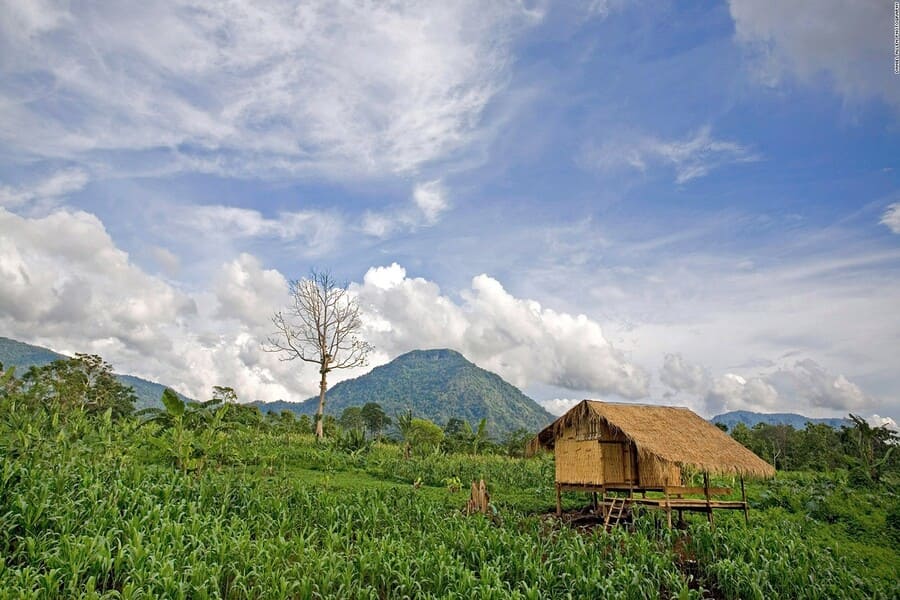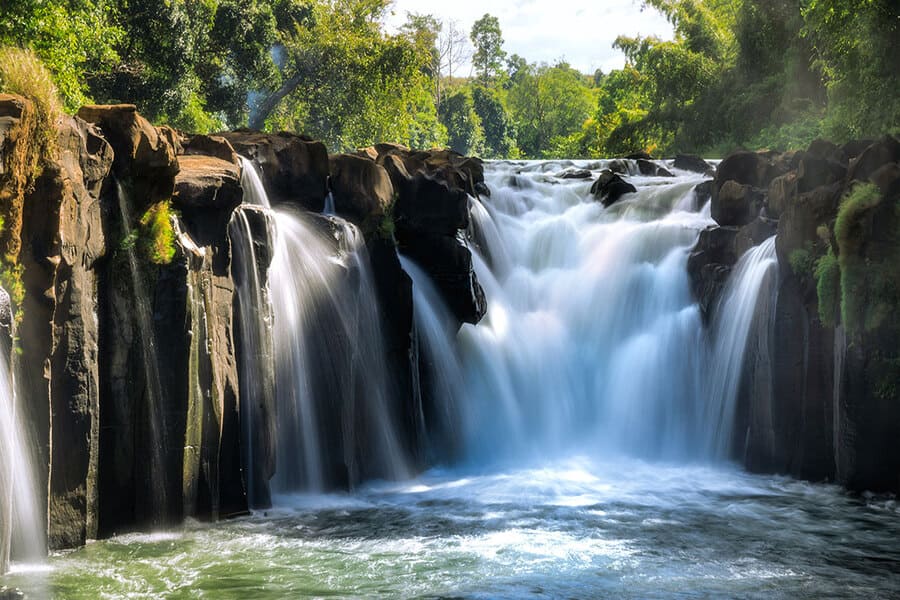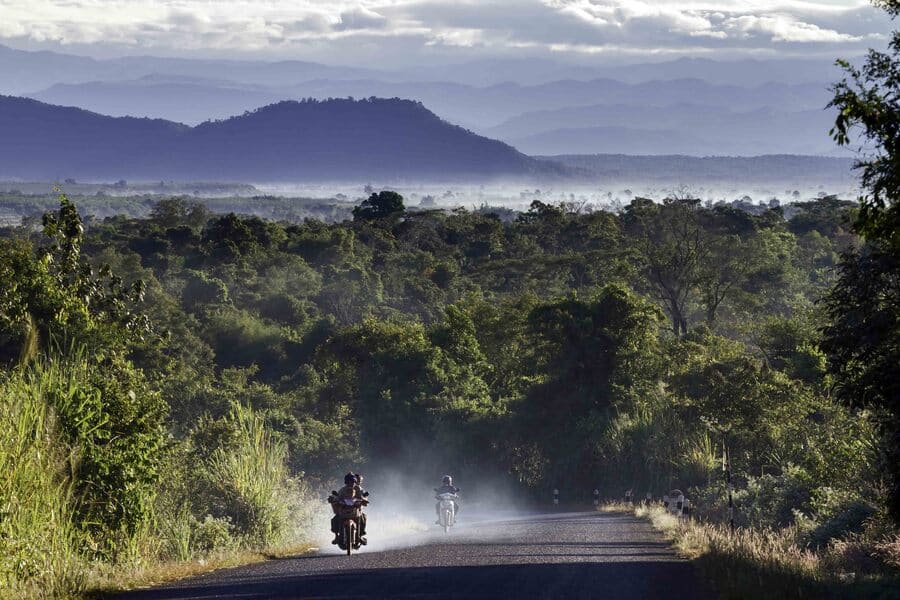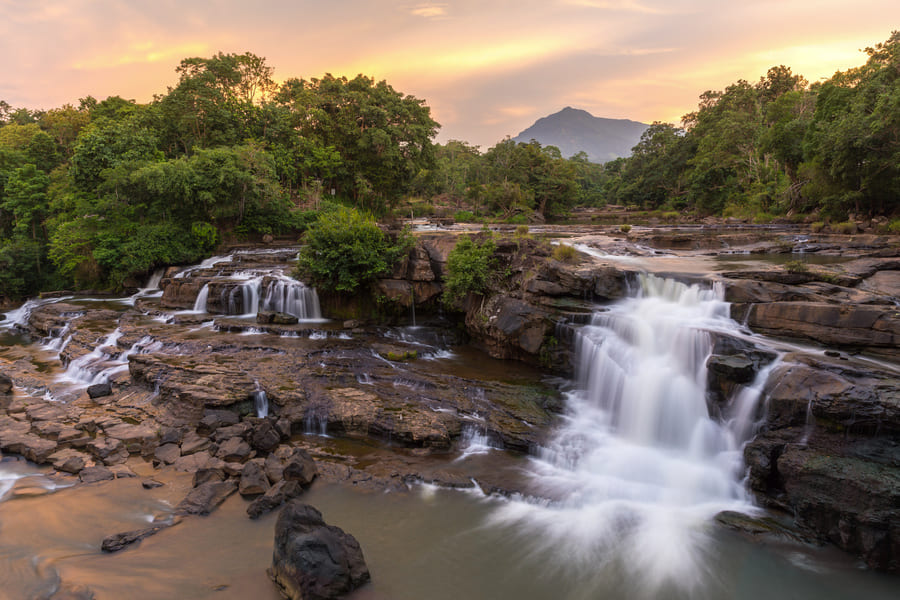Embark on a laos tours to discover the enchanting Bolaven Plateau, a hidden gem renowned for its lush coffee plantations, breathtaking waterfalls, and refreshing cool climate. Located in southern Laos, the Bolaven Plateau offers a serene escape from the hustle and bustle of city life, inviting travelers to immerse themselves in the tranquility of its verdant landscapes and pristine natural beauty.
Location of Bolaven Plateau
The Bolaven Plateau is located in southern Laos . Most of the plateau is found within Champasak Province, although the edges spill over into Salavan, Sekong, and Attapeu Provinces.
What special things in the Bolaven Plateau?
Coffee plantations in Bolaven Plateau
Soaring above the sweltering Laotian lowlands, the Bolaven Plateau offers a haven not just for weary travelers seeking respite from the heat, but also for a crop as precious as gold: coffee. Here, nestled amidst cascading waterfalls and verdant landscapes, sprawling vast coffee plantations, their meticulously tended rows whispering tales of tradition, meticulous care, and a dedication to producing some of the world's finest coffee beans.
The secret to the Bolaven Plateau's coffee prowess lies in a confluence of nature's bounty. The cool, misty climate, a stark contrast to the stifling heat below, provides the perfect growing conditions for Arabica and Robusta coffee beans. The volcanic soil, rich in nutrients, nourishes the plants, imbuing the beans with a depth of flavor unmatched in the lowlands. But nature's gifts alone wouldn't be enough. Generations of Laotian farmers, with a deep understanding of the land and the delicate art of coffee cultivation, have honed their practices over centuries. From the careful selection of seeds to the meticulous hand-picking of ripe cherries, each step is infused with a dedication to quality.
Visitors to the Bolaven Plateau are greeted by a tapestry of emerald green. Rows upon rows of coffee plants stretch towards the horizon, punctuated by the occasional glimpse of a traditional wooden drying shed. Here, the air hangs heavy with the intoxicating aroma of freshly roasted coffee, a promise of the delights to come. Exploring these plantations offers a glimpse into the heart of Laotian coffee culture. Farmers, with weathered hands and sun-kissed smiles, share their knowledge, explaining the intricacies of the bean-to-brew process. Visitors can witness the sun-drying of coffee cherries, a crucial step in developing the beans' unique flavor profile.
The coffee produced on the Bolaven Plateau is anything but ordinary. Arabica beans boast a smooth, complex flavor with notes of citrus and chocolate. Robusta beans, known for their higher caffeine content, offer a bolder taste with a hint of spice. Whether savored as a strong espresso or a slow-drip pour-over, each cup is a testament to the perfect harmony of nature and human ingenuity.
Beyond the economic benefits, the coffee plantations play a vital role in preserving the cultural heritage of the Bolaven Plateau. Many farms are run by ethnic minorities, each group with its own traditions and techniques passed down through generations. By supporting these plantations, visitors contribute to the preservation of this rich cultural tapestry.
Explore Beautiful Waterfalls in Bolaven Plateau
The Bolaven Plateau in southern Laos isn't just a haven for coffee connoisseurs; it's also a paradise for waterfall enthusiasts. Cascading down verdant slopes and plunging into turquoise pools, these waterfalls create a symphony of sound and movement that's both awe-inspiring and invigorating.
The plateau serves as the source for numerous rivers, carving their paths through the landscape and tumbling down in spectacular displays. Some, like Tad Fan, the highest waterfall in Laos, offer breathtaking panoramic views from observation decks. The water crashes down a staggering 130 meters, creating a mesmerizing mist that hangs in the air.
Others, like Tad Lo, are more intimate affairs. Here, visitors can take a refreshing dip in the cool pools at the base of the falls, surrounded by lush greenery and the echoing roar of the cascading water. Tad Hang, meanwhile, offers a multi-tiered experience, with several smaller falls leading up to a grand finale, creating a series of picture-perfect cascades.
The beauty of the Bolaven Plateau waterfalls extends beyond the visual. The constant downpour creates a microclimate of cool mist, a welcome respite from the often scorching Laotian temperatures. The sound of the rushing water is a natural soundtrack, providing a sense of peace and tranquility.
For the adventurous traveler, some waterfalls offer opportunities for trekking and exploration. Hidden trails lead to secluded viewpoints, offering a glimpse of the raw power and majesty of these natural wonders.
The waterfalls of the Bolaven Plateau are more than just tourist attractions; they are the lifeblood of the region. They provide irrigation for the coffee plantations, sustain the diverse ecosystem, and contribute to the unique cultural heritage of the area. Whether you're seeking a refreshing escape, a breathtaking spectacle, or a connection with nature, the waterfalls of the Bolaven Plateau offer an unforgettable experience.
The Climate in Bolaven Plateau
While the lowlands of Laos often bake under the relentless sun, a haven of cool breezes and refreshing temperatures awaits on the Bolaven Plateau. This highland paradise boasts a climate that sets it apart, making it a refuge for both nature and those seeking escape from the tropical heat.
The key to the Bolaven Plateau's unique climate lies in its elevation. Rising over 1,000 meters above sea level, the plateau naturally enjoys cooler temperatures compared to the surrounding lowlands. The average temperature throughout the year hovers around a pleasant 20°C (68°F), offering a welcome respite from the often scorching Laotian summers.
Another defining characteristic of the Bolaven Plateau climate is its high rainfall. Monsoonal patterns bring plentiful rain showers throughout the year, particularly between May and October. This abundant rainfall not only nourishes the lush vegetation and cascading waterfalls but also contributes to the ideal growing conditions for the region's famed coffee plantations.
However, the Bolaven Plateau experiences a subtle yet distinct difference in its climate across the seasons. The wet season, while bringing the life-giving rain, can also be accompanied by occasional mists and fog. This can add a touch of mystical charm to the landscape, especially when combined with the cascading waterfalls. The dry season, from November to April, offers clearer skies and less humidity, making it a popular time for trekking and exploring the plateau.
The cool climate of the Bolaven Plateau isn't just a pleasant perk; it plays a vital role in the ecosystem. The moderate temperatures and abundant rainfall create a haven for diverse plant and animal life. This, in turn, contributes to the overall biodiversity of the region.
How to get to Bolaven Plateau?
There are no airports directly servicing the Bolaven Plateau. Pakse, the capital of Champasak Province, is the most common jumping-off point for exploring the region. Here are the ways to get from Pakse to the Bolaven Plateau:
- Bus: This is the most budget-friendly option. Several public buses travel from Pakse to Thateng, the largest town on the plateau. The ride takes approximately 1.5 hours.
- Minivan: Minivans offer a more comfortable option than buses and can be a good choice if you're traveling with a group. They can be chartered in Pakse and will take you directly to your destination on the plateau.
- Motorbike: Renting a motorbike is a popular option for independent travelers. It allows you to explore the Bolaven Plateau at your own pace and stop at all the interesting viewpoints and waterfalls along the way. Keep in mind that the roads can be winding and mountainous, so be an experienced rider if you choose this option.
- Private Driver: Hiring a private driver is the most convenient option, especially if you don't want to deal with the hassle of navigating the roads yourself. Drivers can be hired in Pakse and will take you to all the highlights of the Bolaven Plateau.
The best time to visit Bolaven Plateau
The best time to visit the Bolaven Plateau in Laos is during the dry season, which typically spans from November to April. During these months, the weather is generally pleasant, with clear skies, mild temperatures, and lower humidity levels, creating optimal conditions for outdoor exploration and sightseeing. Additionally, the dry season is ideal for visiting the plateau's stunning waterfalls and embarking on trekking or cycling adventures amidst the lush greenery of the coffee plantations.
However, it's important to note that the Bolaven Plateau can experience some rainfall even during the dry season, particularly in the early months and towards April. Therefore, it's advisable to bring appropriate rain gear and check the weather forecast before planning your trip.
While the wet season, from May to October, brings more rainfall and higher humidity levels to the region, it also results in lush, verdant landscapes and fewer tourists. Traveling during the wet season can offer a unique opportunity to experience the plateau's natural beauty in a quieter and more tranquil setting, with vibrant greenery and swollen waterfalls.
For visitors, the Bolaven Plateau's climate is more than just weather; it's an integral part of the experience. Whether it's the invigorating morning chill that awakens the senses or the cool evening breezes that provide a comfortable respite, the climate adds a layer of enchantment to this captivating highland destination. So, pack a light jacket and prepare to breathe deeply of the fresh mountain air – the Bolaven Plateau awaits with its refreshing embrace.





